CHCECE003: Provide Care for Children - Assessment Workbook Solution
VerifiedAdded on 2020/03/28
|18
|3713
|46
Homework Assignment
AI Summary
This assessment workbook provides comprehensive answers to questions related to the CHCECE003 unit, focusing on providing care for children. The document covers various aspects of childcare, including the National Quality Standards, UN Rights of the Child, daily routines, transition strategies, and the physical environment. It addresses topics such as promoting positive relationships, supporting children's rights, organizing environments, and handling transitions effectively. The workbook also includes practical scenarios and questions related to sun safety, physical activity, and addressing diverse needs. The provided solutions offer insights into creating supportive environments, understanding children's development, and implementing best practices in early childhood education, making it a valuable resource for students studying childcare and early childhood education.
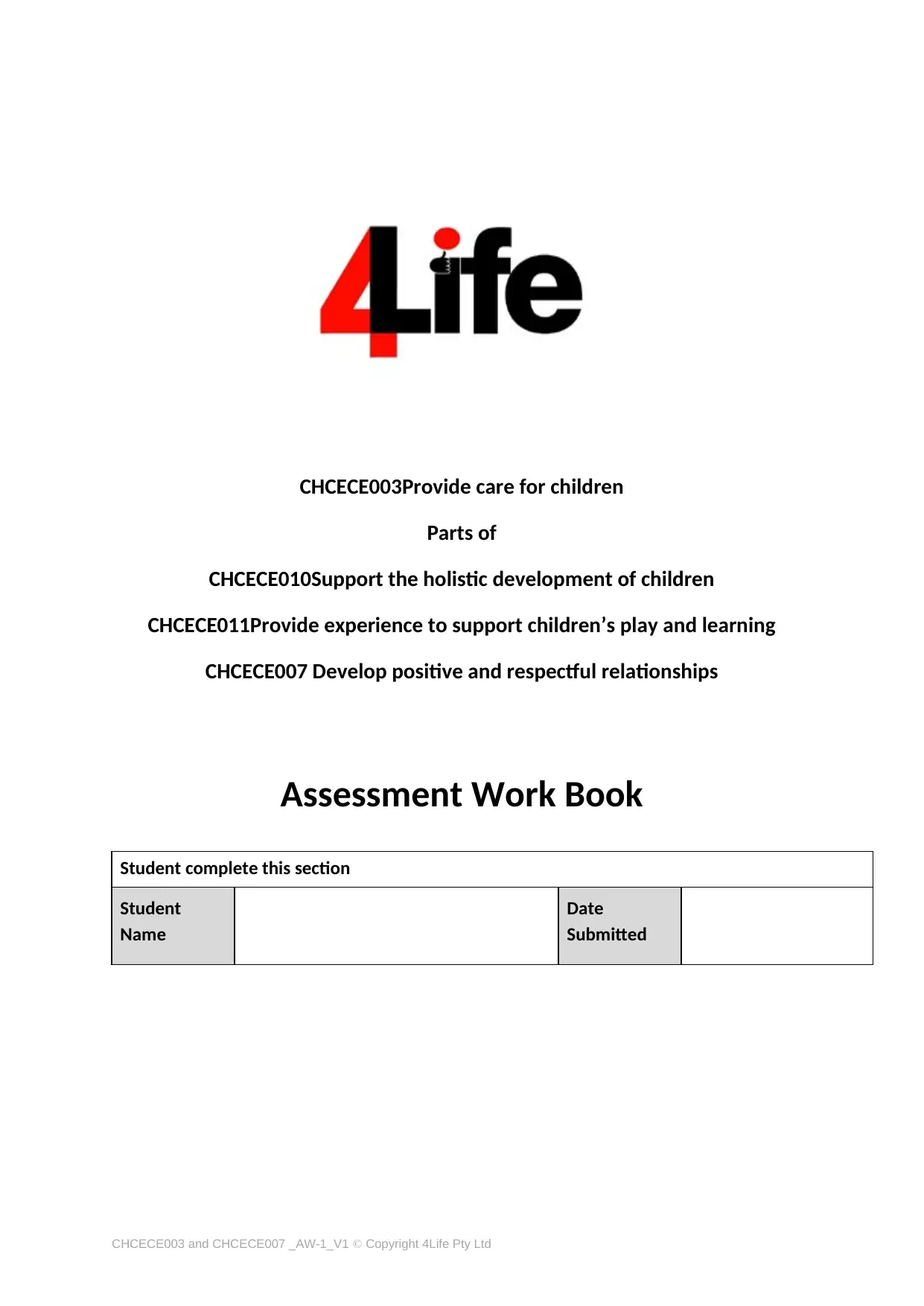
CHCECE003Provide care for children
Parts of
CHCECE010Support the holistic development of children
CHCECE011Provide experience to support children’s play and learning
CHCECE007 Develop positive and respectful relationships
Assessment Work Book
Student complete this section
Student
Name
Date
Submitted
CHCECE003 and CHCECE007 _AW-1_V1 Copyright 4Life Pty Ltd
Parts of
CHCECE010Support the holistic development of children
CHCECE011Provide experience to support children’s play and learning
CHCECE007 Develop positive and respectful relationships
Assessment Work Book
Student complete this section
Student
Name
Date
Submitted
CHCECE003 and CHCECE007 _AW-1_V1 Copyright 4Life Pty Ltd
Paraphrase This Document
Need a fresh take? Get an instant paraphrase of this document with our AI Paraphraser
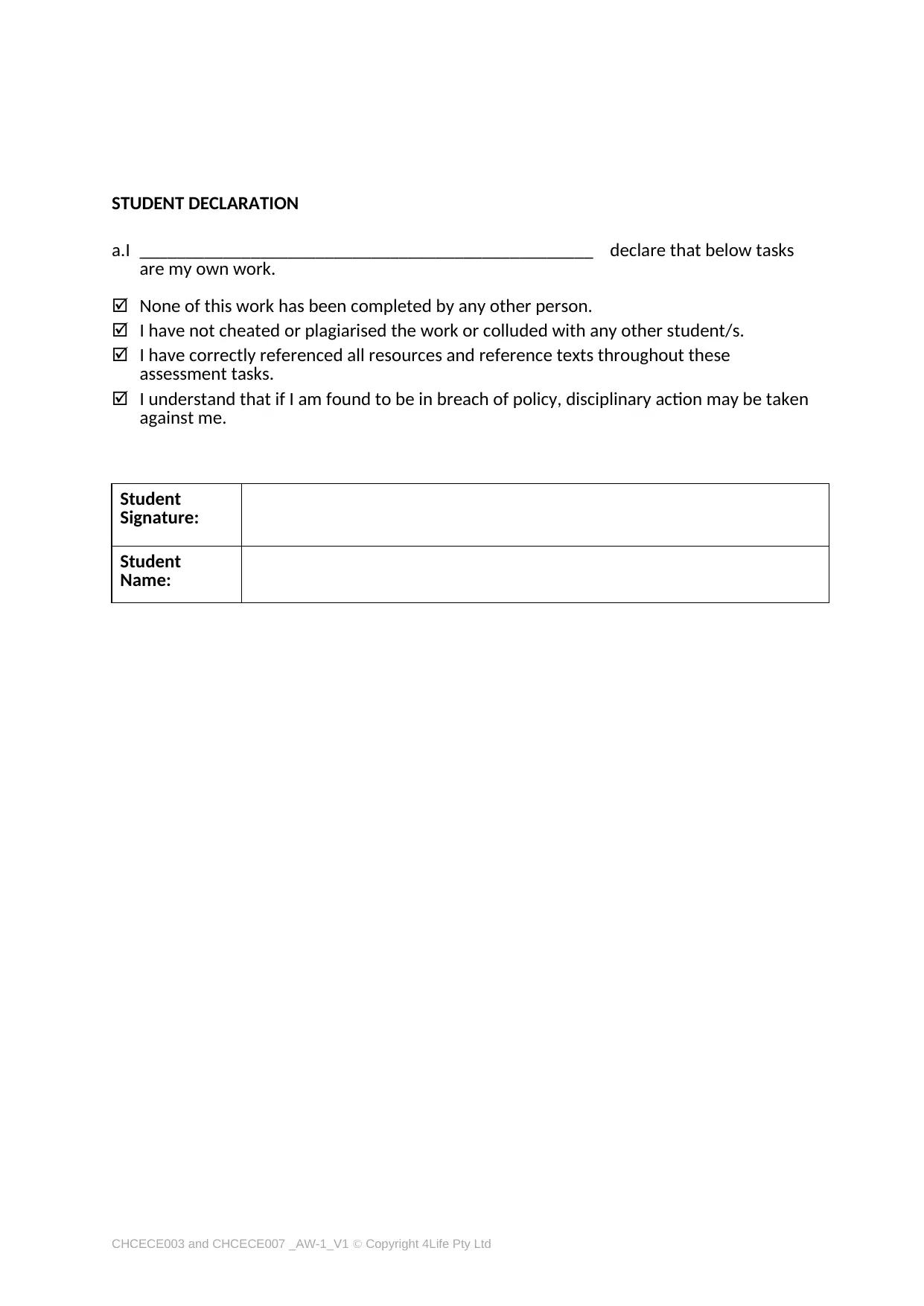
STUDENT DECLARATION
a.I _________________________________________________ declare that below tasks
are my own work.
þ None of this work has been completed by any other person.
þ I have not cheated or plagiarised the work or colluded with any other student/s.
þ I have correctly referenced all resources and reference texts throughout these
assessment tasks.
þ I understand that if I am found to be in breach of policy, disciplinary action may be taken
against me.
Student
Signature:
Student
Name:
CHCECE003 and CHCECE007 _AW-1_V1 Copyright 4Life Pty Ltd
a.I _________________________________________________ declare that below tasks
are my own work.
þ None of this work has been completed by any other person.
þ I have not cheated or plagiarised the work or colluded with any other student/s.
þ I have correctly referenced all resources and reference texts throughout these
assessment tasks.
þ I understand that if I am found to be in breach of policy, disciplinary action may be taken
against me.
Student
Signature:
Student
Name:
CHCECE003 and CHCECE007 _AW-1_V1 Copyright 4Life Pty Ltd
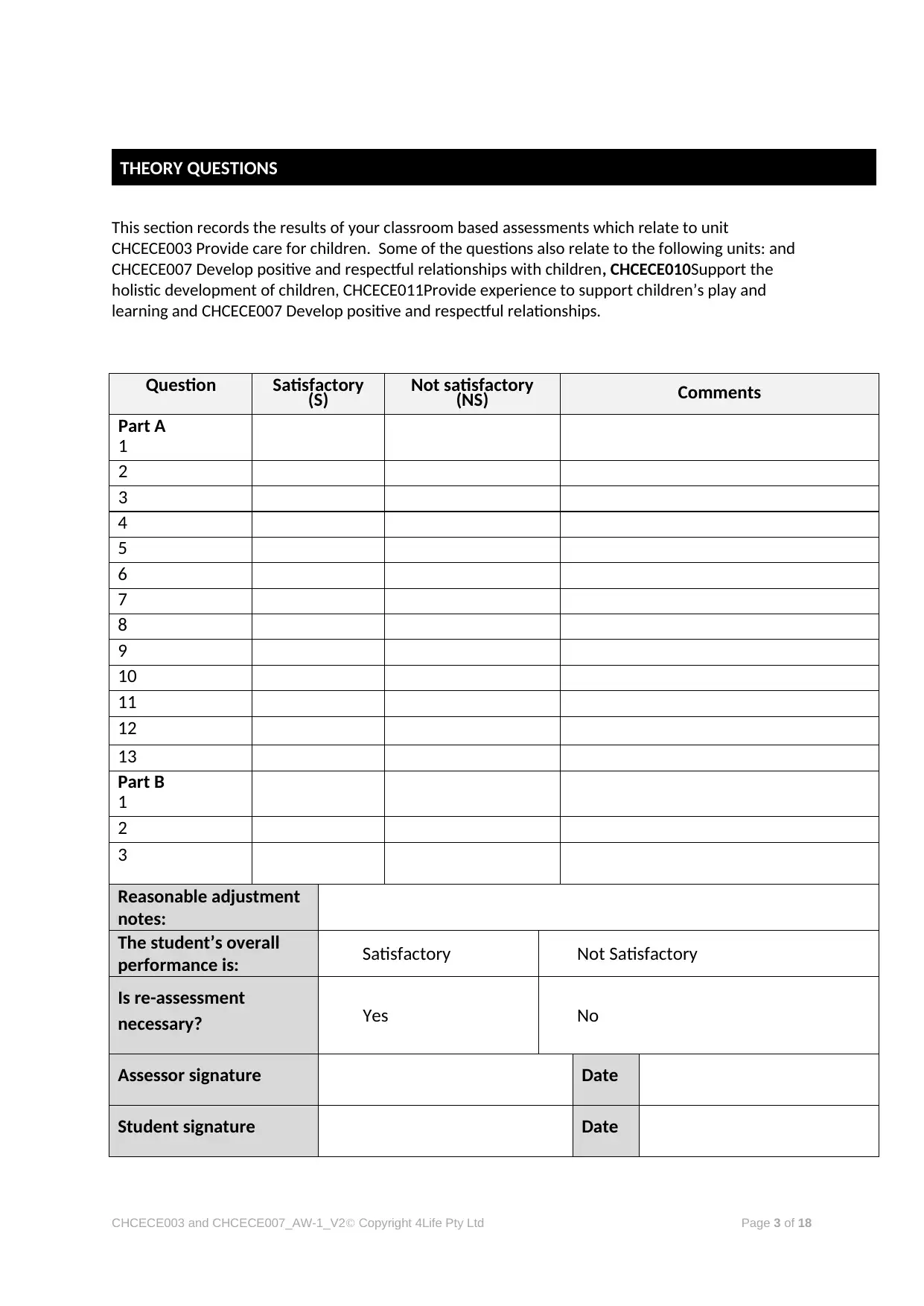
THEORY QUESTIONS
This section records the results of your classroom based assessments which relate to unit
CHCECE003 Provide care for children. Some of the questions also relate to the following units: and
CHCECE007 Develop positive and respectful relationships with children, CHCECE010Support the
holistic development of children, CHCECE011Provide experience to support children’s play and
learning and CHCECE007 Develop positive and respectful relationships.
Question Satisfactory
(S) Not satisfactory
(NS) Comments
Part A
1
2
3
4
5
6
7
8
9
10
11
12
13
Part B
1
2
3
Reasonable adjustment
notes:
The student’s overall
performance is: Satisfactory Not Satisfactory
Is re-assessment
necessary? Yes No
Assessor signature Date
Student signature Date
CHCECE003 and CHCECE007_AW-1_V2 Copyright 4Life Pty Ltd Page 3 of 18
This section records the results of your classroom based assessments which relate to unit
CHCECE003 Provide care for children. Some of the questions also relate to the following units: and
CHCECE007 Develop positive and respectful relationships with children, CHCECE010Support the
holistic development of children, CHCECE011Provide experience to support children’s play and
learning and CHCECE007 Develop positive and respectful relationships.
Question Satisfactory
(S) Not satisfactory
(NS) Comments
Part A
1
2
3
4
5
6
7
8
9
10
11
12
13
Part B
1
2
3
Reasonable adjustment
notes:
The student’s overall
performance is: Satisfactory Not Satisfactory
Is re-assessment
necessary? Yes No
Assessor signature Date
Student signature Date
CHCECE003 and CHCECE007_AW-1_V2 Copyright 4Life Pty Ltd Page 3 of 18
⊘ This is a preview!⊘
Do you want full access?
Subscribe today to unlock all pages.

Trusted by 1+ million students worldwide
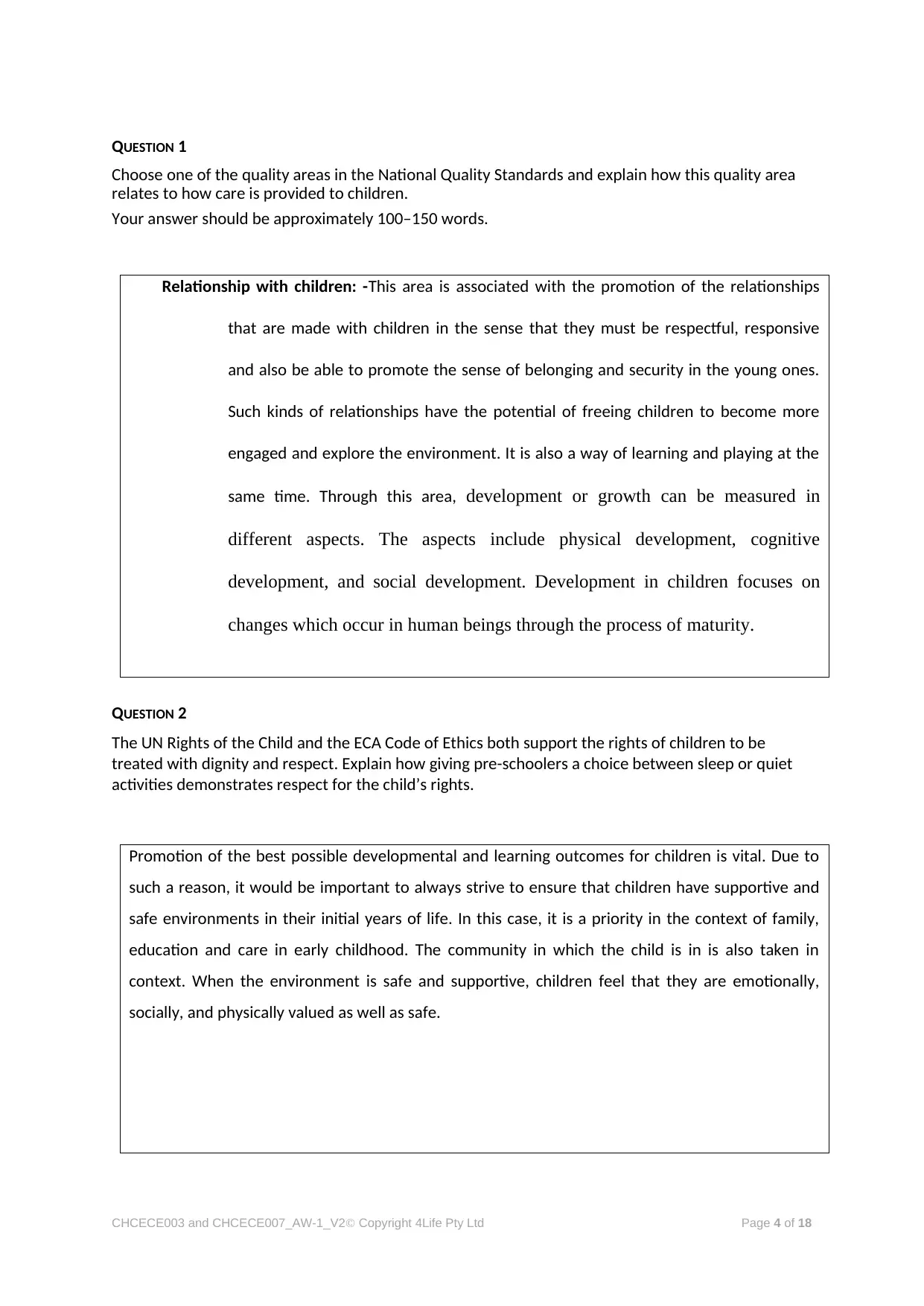
QUESTION 1
Choose one of the quality areas in the National Quality Standards and explain how this quality area
relates to how care is provided to children.
Your answer should be approximately 100–150 words.
Relationship with children: -This area is associated with the promotion of the relationships
that are made with children in the sense that they must be respectful, responsive
and also be able to promote the sense of belonging and security in the young ones.
Such kinds of relationships have the potential of freeing children to become more
engaged and explore the environment. It is also a way of learning and playing at the
same time. Through this area, development or growth can be measured in
different aspects. The aspects include physical development, cognitive
development, and social development. Development in children focuses on
changes which occur in human beings through the process of maturity.
QUESTION 2
The UN Rights of the Child and the ECA Code of Ethics both support the rights of children to be
treated with dignity and respect. Explain how giving pre-schoolers a choice between sleep or quiet
activities demonstrates respect for the child’s rights.
Promotion of the best possible developmental and learning outcomes for children is vital. Due to
such a reason, it would be important to always strive to ensure that children have supportive and
safe environments in their initial years of life. In this case, it is a priority in the context of family,
education and care in early childhood. The community in which the child is in is also taken in
context. When the environment is safe and supportive, children feel that they are emotionally,
socially, and physically valued as well as safe.
CHCECE003 and CHCECE007_AW-1_V2 Copyright 4Life Pty Ltd Page 4 of 18
Choose one of the quality areas in the National Quality Standards and explain how this quality area
relates to how care is provided to children.
Your answer should be approximately 100–150 words.
Relationship with children: -This area is associated with the promotion of the relationships
that are made with children in the sense that they must be respectful, responsive
and also be able to promote the sense of belonging and security in the young ones.
Such kinds of relationships have the potential of freeing children to become more
engaged and explore the environment. It is also a way of learning and playing at the
same time. Through this area, development or growth can be measured in
different aspects. The aspects include physical development, cognitive
development, and social development. Development in children focuses on
changes which occur in human beings through the process of maturity.
QUESTION 2
The UN Rights of the Child and the ECA Code of Ethics both support the rights of children to be
treated with dignity and respect. Explain how giving pre-schoolers a choice between sleep or quiet
activities demonstrates respect for the child’s rights.
Promotion of the best possible developmental and learning outcomes for children is vital. Due to
such a reason, it would be important to always strive to ensure that children have supportive and
safe environments in their initial years of life. In this case, it is a priority in the context of family,
education and care in early childhood. The community in which the child is in is also taken in
context. When the environment is safe and supportive, children feel that they are emotionally,
socially, and physically valued as well as safe.
CHCECE003 and CHCECE007_AW-1_V2 Copyright 4Life Pty Ltd Page 4 of 18
Paraphrase This Document
Need a fresh take? Get an instant paraphrase of this document with our AI Paraphraser
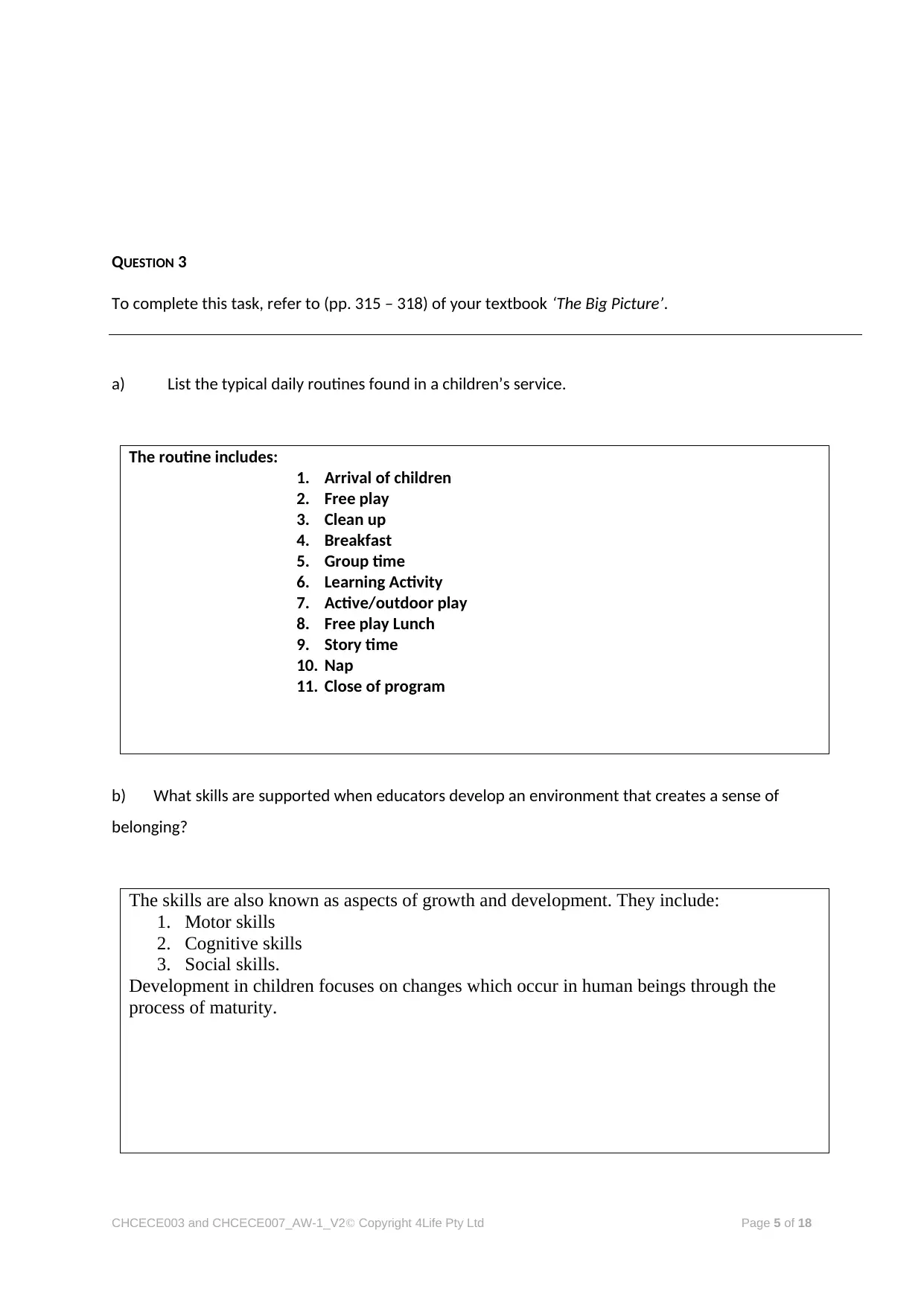
QUESTION 3
To complete this task, refer to (pp. 315 – 318) of your textbook ‘The Big Picture’.
a) List the typical daily routines found in a children’s service.
The routine includes:
1. Arrival of children
2. Free play
3. Clean up
4. Breakfast
5. Group time
6. Learning Activity
7. Active/outdoor play
8. Free play Lunch
9. Story time
10. Nap
11. Close of program
b) What skills are supported when educators develop an environment that creates a sense of
belonging?
The skills are also known as aspects of growth and development. They include:
1. Motor skills
2. Cognitive skills
3. Social skills.
Development in children focuses on changes which occur in human beings through the
process of maturity.
CHCECE003 and CHCECE007_AW-1_V2 Copyright 4Life Pty Ltd Page 5 of 18
To complete this task, refer to (pp. 315 – 318) of your textbook ‘The Big Picture’.
a) List the typical daily routines found in a children’s service.
The routine includes:
1. Arrival of children
2. Free play
3. Clean up
4. Breakfast
5. Group time
6. Learning Activity
7. Active/outdoor play
8. Free play Lunch
9. Story time
10. Nap
11. Close of program
b) What skills are supported when educators develop an environment that creates a sense of
belonging?
The skills are also known as aspects of growth and development. They include:
1. Motor skills
2. Cognitive skills
3. Social skills.
Development in children focuses on changes which occur in human beings through the
process of maturity.
CHCECE003 and CHCECE007_AW-1_V2 Copyright 4Life Pty Ltd Page 5 of 18
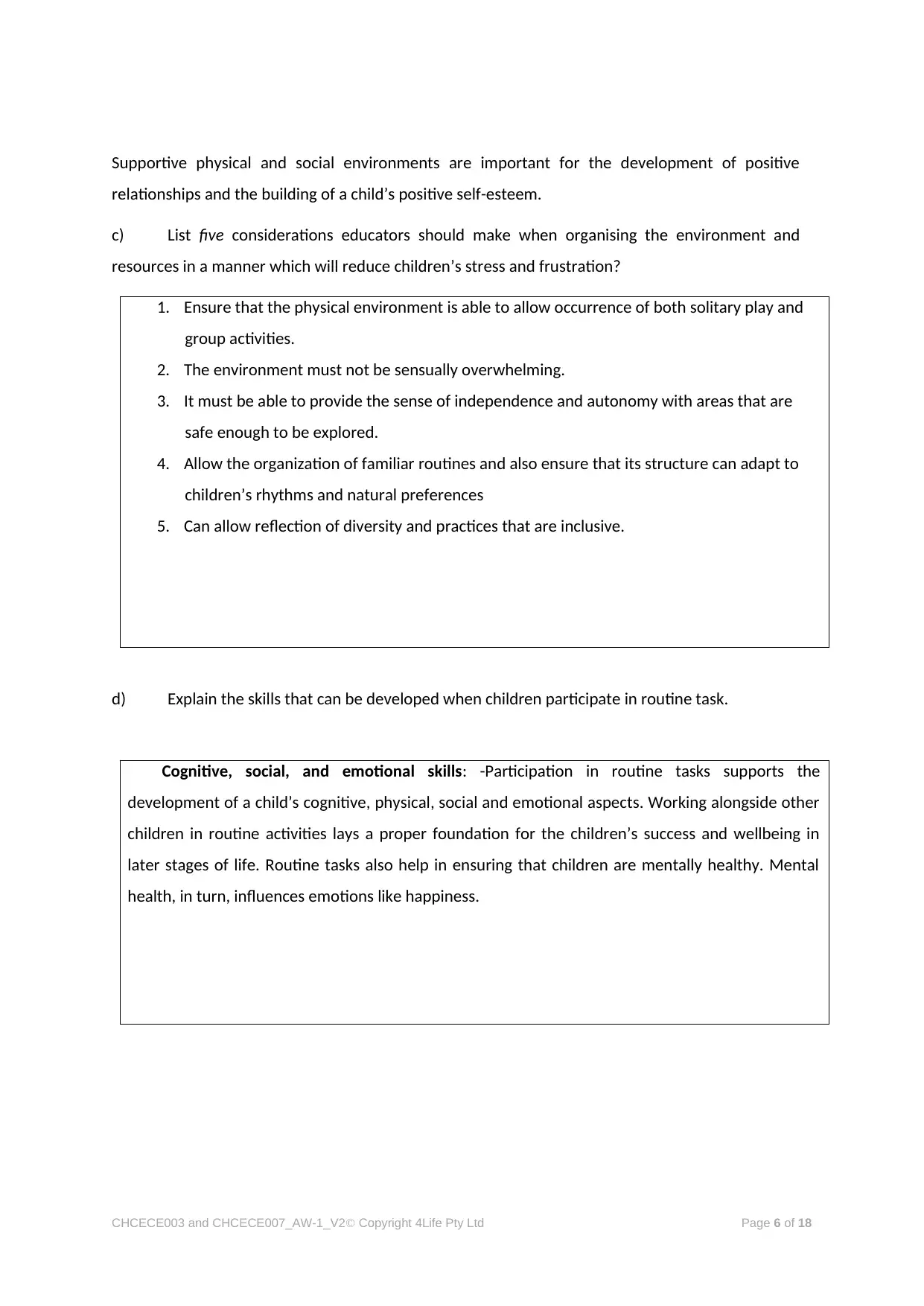
Supportive physical and social environments are important for the development of positive
relationships and the building of a child’s positive self-esteem.
c) List five considerations educators should make when organising the environment and
resources in a manner which will reduce children’s stress and frustration?
1. Ensure that the physical environment is able to allow occurrence of both solitary play and
group activities.
2. The environment must not be sensually overwhelming.
3. It must be able to provide the sense of independence and autonomy with areas that are
safe enough to be explored.
4. Allow the organization of familiar routines and also ensure that its structure can adapt to
children’s rhythms and natural preferences
5. Can allow reflection of diversity and practices that are inclusive.
d) Explain the skills that can be developed when children participate in routine task.
Cognitive, social, and emotional skills: -Participation in routine tasks supports the
development of a child’s cognitive, physical, social and emotional aspects. Working alongside other
children in routine activities lays a proper foundation for the children’s success and wellbeing in
later stages of life. Routine tasks also help in ensuring that children are mentally healthy. Mental
health, in turn, influences emotions like happiness.
CHCECE003 and CHCECE007_AW-1_V2 Copyright 4Life Pty Ltd Page 6 of 18
relationships and the building of a child’s positive self-esteem.
c) List five considerations educators should make when organising the environment and
resources in a manner which will reduce children’s stress and frustration?
1. Ensure that the physical environment is able to allow occurrence of both solitary play and
group activities.
2. The environment must not be sensually overwhelming.
3. It must be able to provide the sense of independence and autonomy with areas that are
safe enough to be explored.
4. Allow the organization of familiar routines and also ensure that its structure can adapt to
children’s rhythms and natural preferences
5. Can allow reflection of diversity and practices that are inclusive.
d) Explain the skills that can be developed when children participate in routine task.
Cognitive, social, and emotional skills: -Participation in routine tasks supports the
development of a child’s cognitive, physical, social and emotional aspects. Working alongside other
children in routine activities lays a proper foundation for the children’s success and wellbeing in
later stages of life. Routine tasks also help in ensuring that children are mentally healthy. Mental
health, in turn, influences emotions like happiness.
CHCECE003 and CHCECE007_AW-1_V2 Copyright 4Life Pty Ltd Page 6 of 18
⊘ This is a preview!⊘
Do you want full access?
Subscribe today to unlock all pages.

Trusted by 1+ million students worldwide
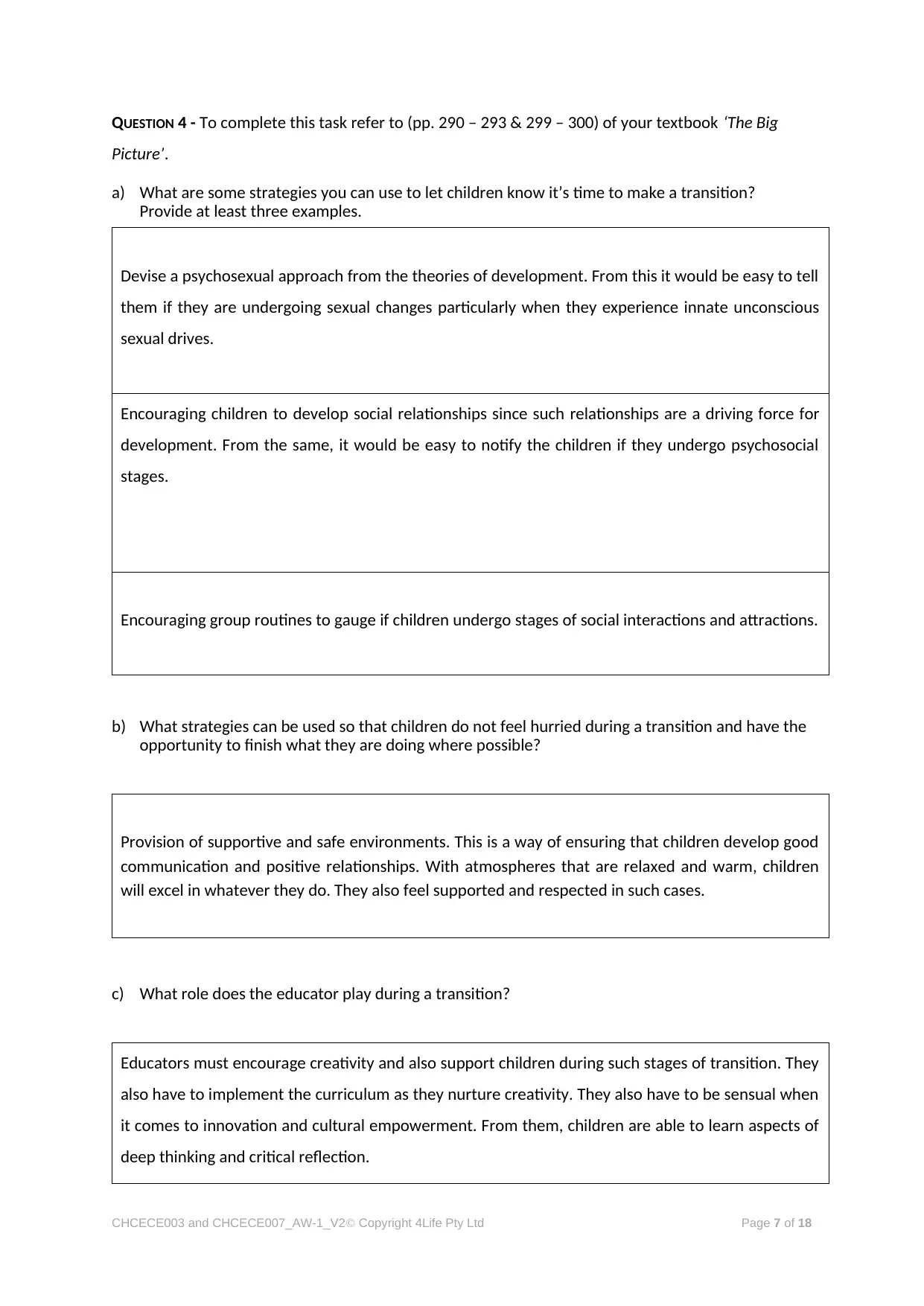
QUESTION 4 - To complete this task refer to (pp. 290 – 293 & 299 – 300) of your textbook ‘The Big
Picture’.
a) What are some strategies you can use to let children know it’s time to make a transition?
Provide at least three examples.
Devise a psychosexual approach from the theories of development. From this it would be easy to tell
them if they are undergoing sexual changes particularly when they experience innate unconscious
sexual drives.
Encouraging children to develop social relationships since such relationships are a driving force for
development. From the same, it would be easy to notify the children if they undergo psychosocial
stages.
Encouraging group routines to gauge if children undergo stages of social interactions and attractions.
b) What strategies can be used so that children do not feel hurried during a transition and have the
opportunity to finish what they are doing where possible?
Provision of supportive and safe environments. This is a way of ensuring that children develop good
communication and positive relationships. With atmospheres that are relaxed and warm, children
will excel in whatever they do. They also feel supported and respected in such cases.
c) What role does the educator play during a transition?
Educators must encourage creativity and also support children during such stages of transition. They
also have to implement the curriculum as they nurture creativity. They also have to be sensual when
it comes to innovation and cultural empowerment. From them, children are able to learn aspects of
deep thinking and critical reflection.
CHCECE003 and CHCECE007_AW-1_V2 Copyright 4Life Pty Ltd Page 7 of 18
Picture’.
a) What are some strategies you can use to let children know it’s time to make a transition?
Provide at least three examples.
Devise a psychosexual approach from the theories of development. From this it would be easy to tell
them if they are undergoing sexual changes particularly when they experience innate unconscious
sexual drives.
Encouraging children to develop social relationships since such relationships are a driving force for
development. From the same, it would be easy to notify the children if they undergo psychosocial
stages.
Encouraging group routines to gauge if children undergo stages of social interactions and attractions.
b) What strategies can be used so that children do not feel hurried during a transition and have the
opportunity to finish what they are doing where possible?
Provision of supportive and safe environments. This is a way of ensuring that children develop good
communication and positive relationships. With atmospheres that are relaxed and warm, children
will excel in whatever they do. They also feel supported and respected in such cases.
c) What role does the educator play during a transition?
Educators must encourage creativity and also support children during such stages of transition. They
also have to implement the curriculum as they nurture creativity. They also have to be sensual when
it comes to innovation and cultural empowerment. From them, children are able to learn aspects of
deep thinking and critical reflection.
CHCECE003 and CHCECE007_AW-1_V2 Copyright 4Life Pty Ltd Page 7 of 18
Paraphrase This Document
Need a fresh take? Get an instant paraphrase of this document with our AI Paraphraser
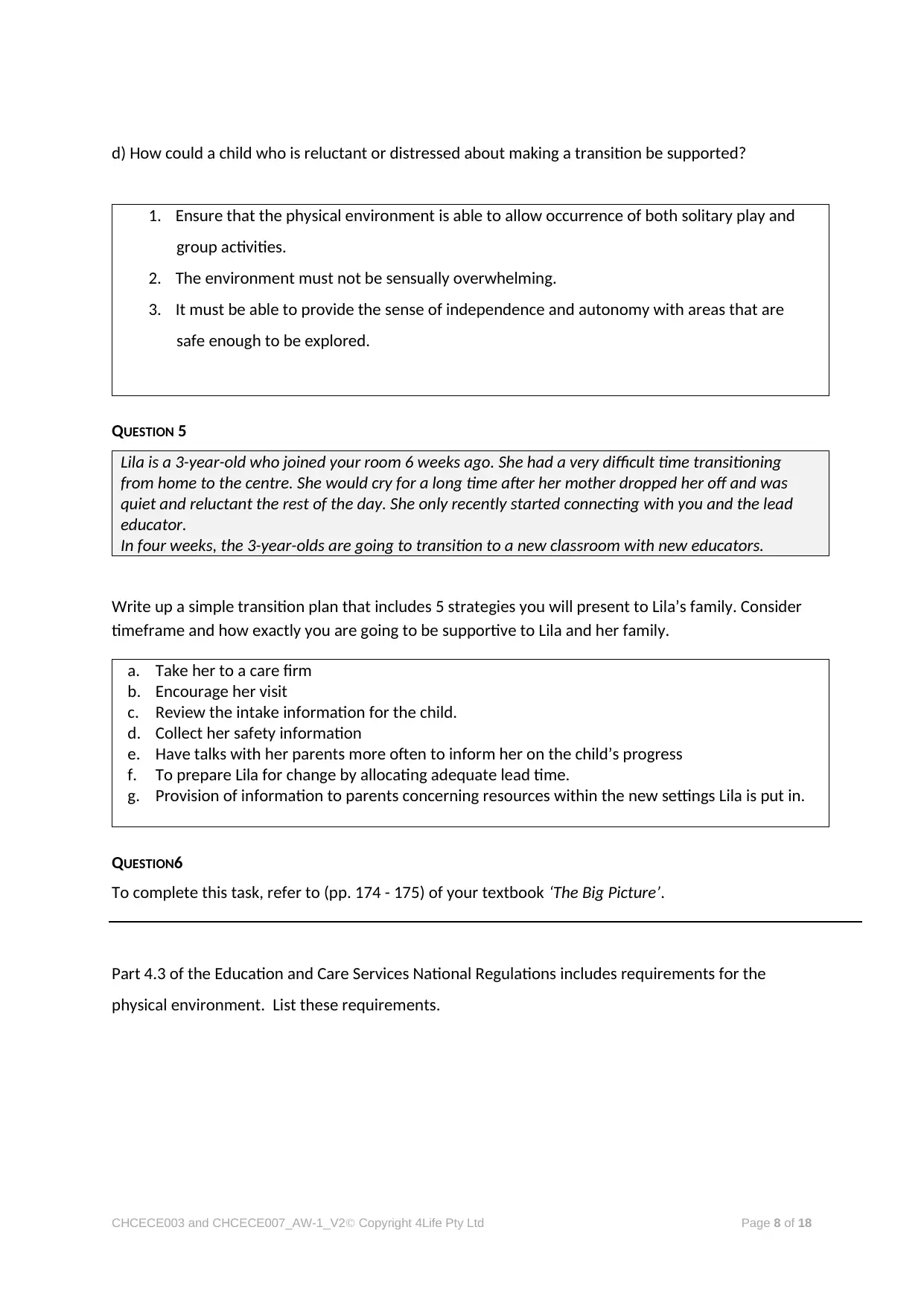
d) How could a child who is reluctant or distressed about making a transition be supported?
1. Ensure that the physical environment is able to allow occurrence of both solitary play and
group activities.
2. The environment must not be sensually overwhelming.
3. It must be able to provide the sense of independence and autonomy with areas that are
safe enough to be explored.
QUESTION 5
Lila is a 3-year-old who joined your room 6 weeks ago. She had a very difficult time transitioning
from home to the centre. She would cry for a long time after her mother dropped her off and was
quiet and reluctant the rest of the day. She only recently started connecting with you and the lead
educator.
In four weeks, the 3-year-olds are going to transition to a new classroom with new educators.
Write up a simple transition plan that includes 5 strategies you will present to Lila’s family. Consider
timeframe and how exactly you are going to be supportive to Lila and her family.
a. Take her to a care firm
b. Encourage her visit
c. Review the intake information for the child.
d. Collect her safety information
e. Have talks with her parents more often to inform her on the child’s progress
f. To prepare Lila for change by allocating adequate lead time.
g. Provision of information to parents concerning resources within the new settings Lila is put in.
QUESTION6
To complete this task, refer to (pp. 174 - 175) of your textbook ‘The Big Picture’.
Part 4.3 of the Education and Care Services National Regulations includes requirements for the
physical environment. List these requirements.
CHCECE003 and CHCECE007_AW-1_V2 Copyright 4Life Pty Ltd Page 8 of 18
1. Ensure that the physical environment is able to allow occurrence of both solitary play and
group activities.
2. The environment must not be sensually overwhelming.
3. It must be able to provide the sense of independence and autonomy with areas that are
safe enough to be explored.
QUESTION 5
Lila is a 3-year-old who joined your room 6 weeks ago. She had a very difficult time transitioning
from home to the centre. She would cry for a long time after her mother dropped her off and was
quiet and reluctant the rest of the day. She only recently started connecting with you and the lead
educator.
In four weeks, the 3-year-olds are going to transition to a new classroom with new educators.
Write up a simple transition plan that includes 5 strategies you will present to Lila’s family. Consider
timeframe and how exactly you are going to be supportive to Lila and her family.
a. Take her to a care firm
b. Encourage her visit
c. Review the intake information for the child.
d. Collect her safety information
e. Have talks with her parents more often to inform her on the child’s progress
f. To prepare Lila for change by allocating adequate lead time.
g. Provision of information to parents concerning resources within the new settings Lila is put in.
QUESTION6
To complete this task, refer to (pp. 174 - 175) of your textbook ‘The Big Picture’.
Part 4.3 of the Education and Care Services National Regulations includes requirements for the
physical environment. List these requirements.
CHCECE003 and CHCECE007_AW-1_V2 Copyright 4Life Pty Ltd Page 8 of 18
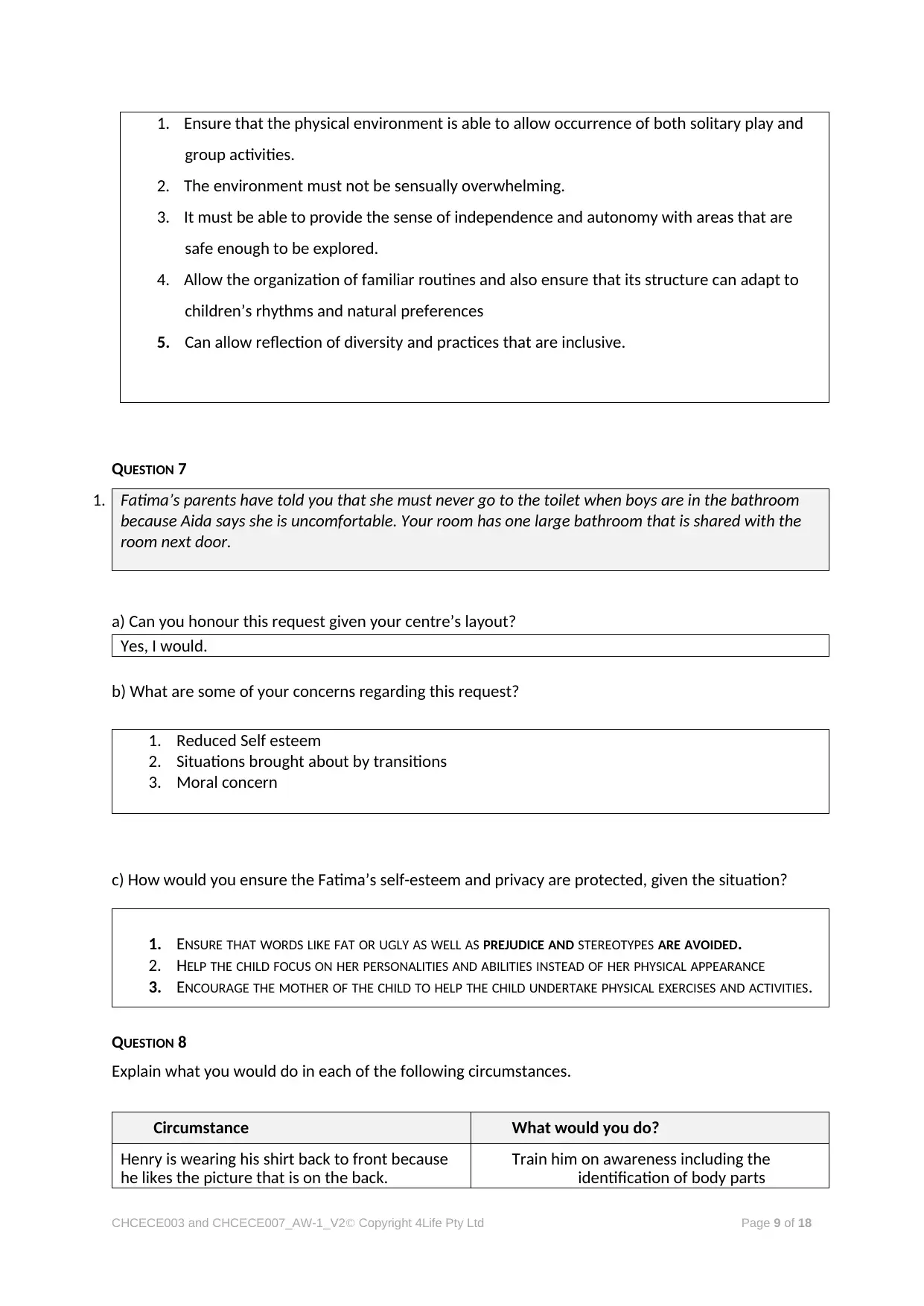
1. Ensure that the physical environment is able to allow occurrence of both solitary play and
group activities.
2. The environment must not be sensually overwhelming.
3. It must be able to provide the sense of independence and autonomy with areas that are
safe enough to be explored.
4. Allow the organization of familiar routines and also ensure that its structure can adapt to
children’s rhythms and natural preferences
5. Can allow reflection of diversity and practices that are inclusive.
QUESTION 7
1. Fatima’s parents have told you that she must never go to the toilet when boys are in the bathroom
because Aida says she is uncomfortable. Your room has one large bathroom that is shared with the
room next door.
a) Can you honour this request given your centre’s layout?
Yes, I would.
b) What are some of your concerns regarding this request?
1. Reduced Self esteem
2. Situations brought about by transitions
3. Moral concern
c) How would you ensure the Fatima’s self-esteem and privacy are protected, given the situation?
1. ENSURE THAT WORDS LIKE FAT OR UGLY AS WELL AS PREJUDICE AND STEREOTYPES ARE AVOIDED.
2. HELP THE CHILD FOCUS ON HER PERSONALITIES AND ABILITIES INSTEAD OF HER PHYSICAL APPEARANCE
3. ENCOURAGE THE MOTHER OF THE CHILD TO HELP THE CHILD UNDERTAKE PHYSICAL EXERCISES AND ACTIVITIES.
QUESTION 8
Explain what you would do in each of the following circumstances.
Circumstance What would you do?
Henry is wearing his shirt back to front because
he likes the picture that is on the back.
Train him on awareness including the
identification of body parts
CHCECE003 and CHCECE007_AW-1_V2 Copyright 4Life Pty Ltd Page 9 of 18
group activities.
2. The environment must not be sensually overwhelming.
3. It must be able to provide the sense of independence and autonomy with areas that are
safe enough to be explored.
4. Allow the organization of familiar routines and also ensure that its structure can adapt to
children’s rhythms and natural preferences
5. Can allow reflection of diversity and practices that are inclusive.
QUESTION 7
1. Fatima’s parents have told you that she must never go to the toilet when boys are in the bathroom
because Aida says she is uncomfortable. Your room has one large bathroom that is shared with the
room next door.
a) Can you honour this request given your centre’s layout?
Yes, I would.
b) What are some of your concerns regarding this request?
1. Reduced Self esteem
2. Situations brought about by transitions
3. Moral concern
c) How would you ensure the Fatima’s self-esteem and privacy are protected, given the situation?
1. ENSURE THAT WORDS LIKE FAT OR UGLY AS WELL AS PREJUDICE AND STEREOTYPES ARE AVOIDED.
2. HELP THE CHILD FOCUS ON HER PERSONALITIES AND ABILITIES INSTEAD OF HER PHYSICAL APPEARANCE
3. ENCOURAGE THE MOTHER OF THE CHILD TO HELP THE CHILD UNDERTAKE PHYSICAL EXERCISES AND ACTIVITIES.
QUESTION 8
Explain what you would do in each of the following circumstances.
Circumstance What would you do?
Henry is wearing his shirt back to front because
he likes the picture that is on the back.
Train him on awareness including the
identification of body parts
CHCECE003 and CHCECE007_AW-1_V2 Copyright 4Life Pty Ltd Page 9 of 18
⊘ This is a preview!⊘
Do you want full access?
Subscribe today to unlock all pages.

Trusted by 1+ million students worldwide
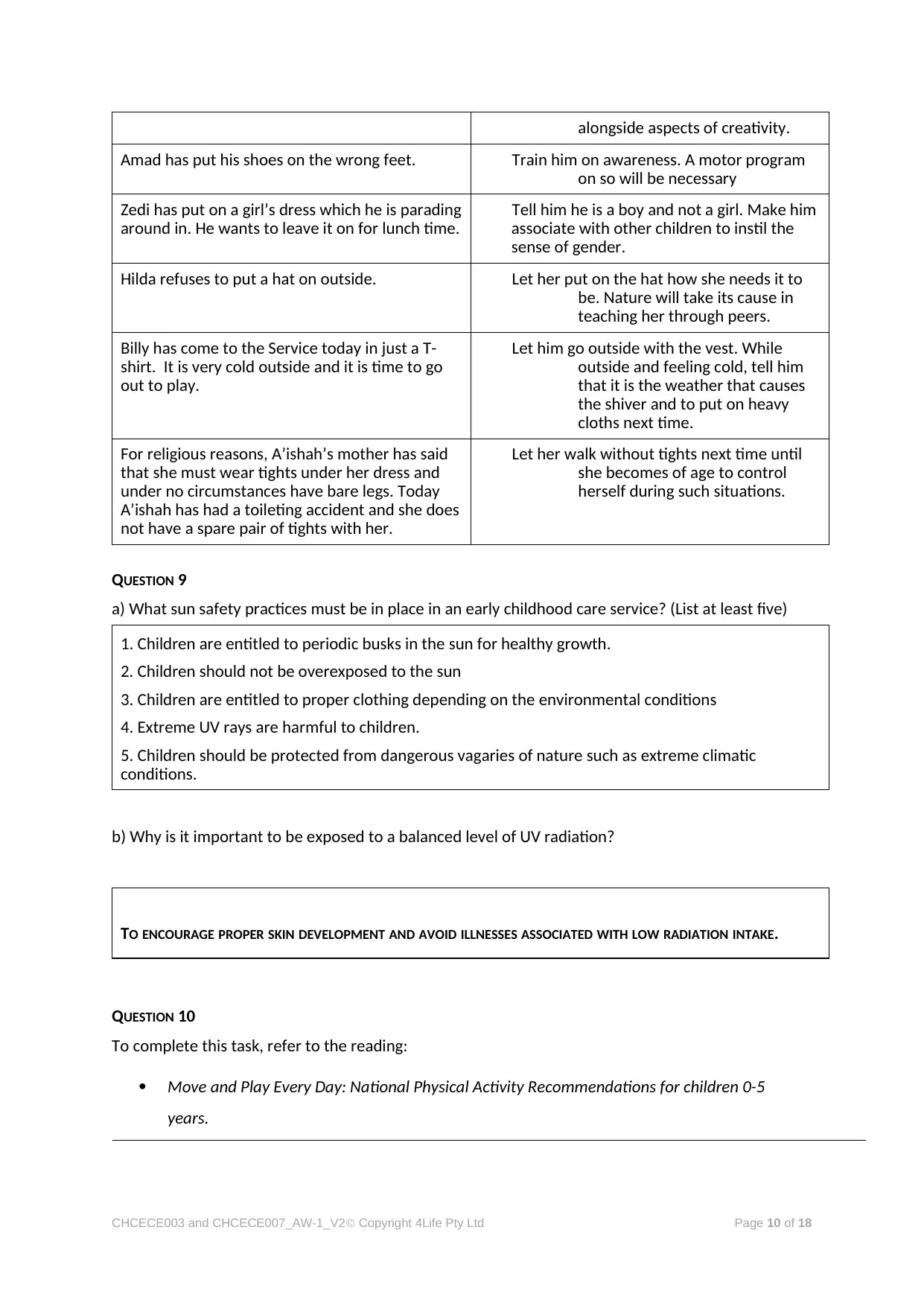
alongside aspects of creativity.
Amad has put his shoes on the wrong feet. Train him on awareness. A motor program
on so will be necessary
Zedi has put on a girl’s dress which he is parading
around in. He wants to leave it on for lunch time.
Tell him he is a boy and not a girl. Make him
associate with other children to instil the
sense of gender.
Hilda refuses to put a hat on outside. Let her put on the hat how she needs it to
be. Nature will take its cause in
teaching her through peers.
Billy has come to the Service today in just a T-
shirt. It is very cold outside and it is time to go
out to play.
Let him go outside with the vest. While
outside and feeling cold, tell him
that it is the weather that causes
the shiver and to put on heavy
cloths next time.
For religious reasons, A’ishah’s mother has said
that she must wear tights under her dress and
under no circumstances have bare legs. Today
A’ishah has had a toileting accident and she does
not have a spare pair of tights with her.
Let her walk without tights next time until
she becomes of age to control
herself during such situations.
QUESTION 9
a) What sun safety practices must be in place in an early childhood care service? (List at least five)
1. Children are entitled to periodic busks in the sun for healthy growth.
2. Children should not be overexposed to the sun
3. Children are entitled to proper clothing depending on the environmental conditions
4. Extreme UV rays are harmful to children.
5. Children should be protected from dangerous vagaries of nature such as extreme climatic
conditions.
b) Why is it important to be exposed to a balanced level of UV radiation?
TO ENCOURAGE PROPER SKIN DEVELOPMENT AND AVOID ILLNESSES ASSOCIATED WITH LOW RADIATION INTAKE.
QUESTION 10
To complete this task, refer to the reading:
Move and Play Every Day: National Physical Activity Recommendations for children 0-5
years.
CHCECE003 and CHCECE007_AW-1_V2 Copyright 4Life Pty Ltd Page 10 of 18
Amad has put his shoes on the wrong feet. Train him on awareness. A motor program
on so will be necessary
Zedi has put on a girl’s dress which he is parading
around in. He wants to leave it on for lunch time.
Tell him he is a boy and not a girl. Make him
associate with other children to instil the
sense of gender.
Hilda refuses to put a hat on outside. Let her put on the hat how she needs it to
be. Nature will take its cause in
teaching her through peers.
Billy has come to the Service today in just a T-
shirt. It is very cold outside and it is time to go
out to play.
Let him go outside with the vest. While
outside and feeling cold, tell him
that it is the weather that causes
the shiver and to put on heavy
cloths next time.
For religious reasons, A’ishah’s mother has said
that she must wear tights under her dress and
under no circumstances have bare legs. Today
A’ishah has had a toileting accident and she does
not have a spare pair of tights with her.
Let her walk without tights next time until
she becomes of age to control
herself during such situations.
QUESTION 9
a) What sun safety practices must be in place in an early childhood care service? (List at least five)
1. Children are entitled to periodic busks in the sun for healthy growth.
2. Children should not be overexposed to the sun
3. Children are entitled to proper clothing depending on the environmental conditions
4. Extreme UV rays are harmful to children.
5. Children should be protected from dangerous vagaries of nature such as extreme climatic
conditions.
b) Why is it important to be exposed to a balanced level of UV radiation?
TO ENCOURAGE PROPER SKIN DEVELOPMENT AND AVOID ILLNESSES ASSOCIATED WITH LOW RADIATION INTAKE.
QUESTION 10
To complete this task, refer to the reading:
Move and Play Every Day: National Physical Activity Recommendations for children 0-5
years.
CHCECE003 and CHCECE007_AW-1_V2 Copyright 4Life Pty Ltd Page 10 of 18
Paraphrase This Document
Need a fresh take? Get an instant paraphrase of this document with our AI Paraphraser
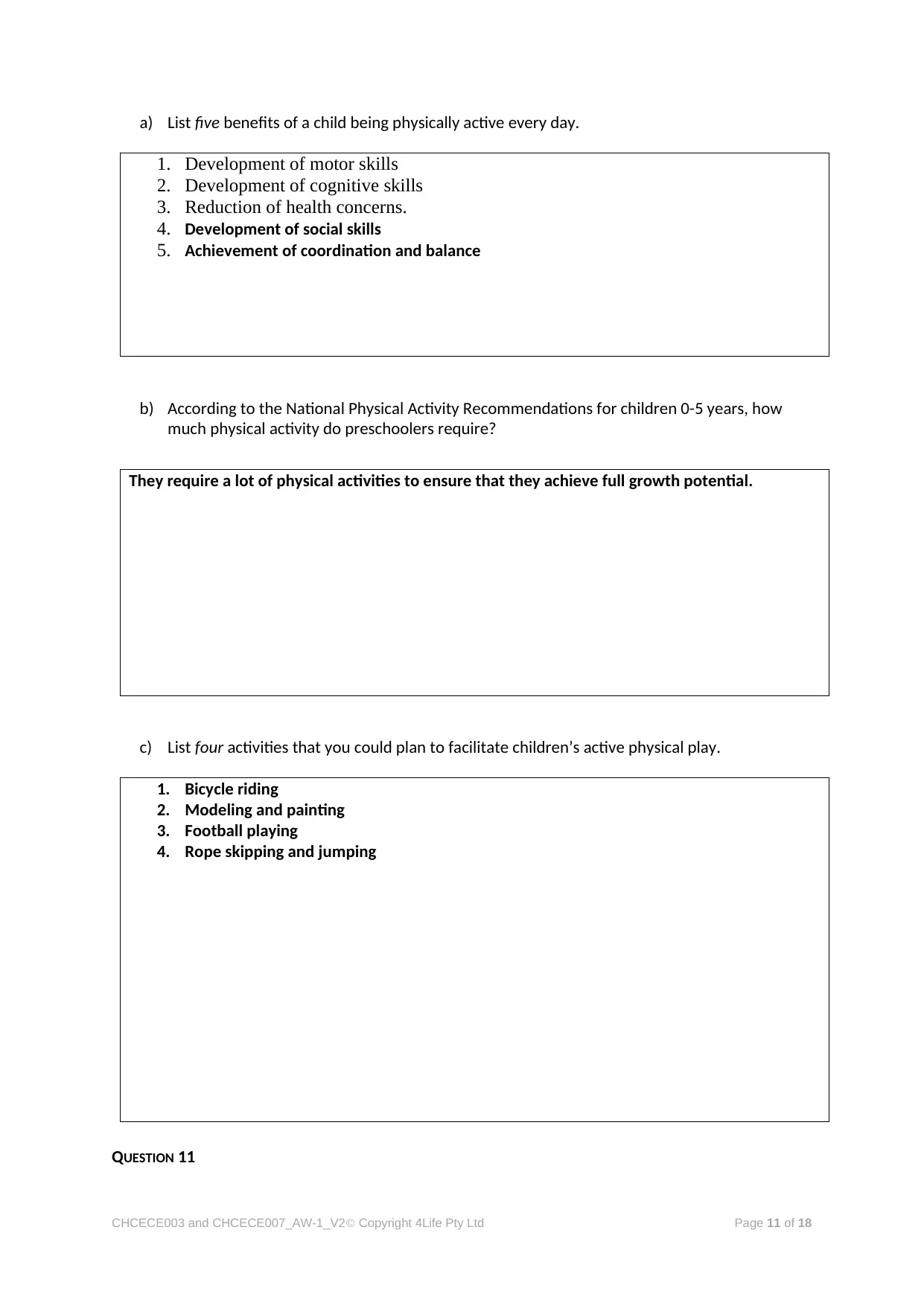
a) List five benefits of a child being physically active every day.
1. Development of motor skills
2. Development of cognitive skills
3. Reduction of health concerns.
4. Development of social skills
5. Achievement of coordination and balance
b) According to the National Physical Activity Recommendations for children 0-5 years, how
much physical activity do preschoolers require?
They require a lot of physical activities to ensure that they achieve full growth potential.
c) List four activities that you could plan to facilitate children’s active physical play.
1. Bicycle riding
2. Modeling and painting
3. Football playing
4. Rope skipping and jumping
QUESTION 11
CHCECE003 and CHCECE007_AW-1_V2 Copyright 4Life Pty Ltd Page 11 of 18
1. Development of motor skills
2. Development of cognitive skills
3. Reduction of health concerns.
4. Development of social skills
5. Achievement of coordination and balance
b) According to the National Physical Activity Recommendations for children 0-5 years, how
much physical activity do preschoolers require?
They require a lot of physical activities to ensure that they achieve full growth potential.
c) List four activities that you could plan to facilitate children’s active physical play.
1. Bicycle riding
2. Modeling and painting
3. Football playing
4. Rope skipping and jumping
QUESTION 11
CHCECE003 and CHCECE007_AW-1_V2 Copyright 4Life Pty Ltd Page 11 of 18
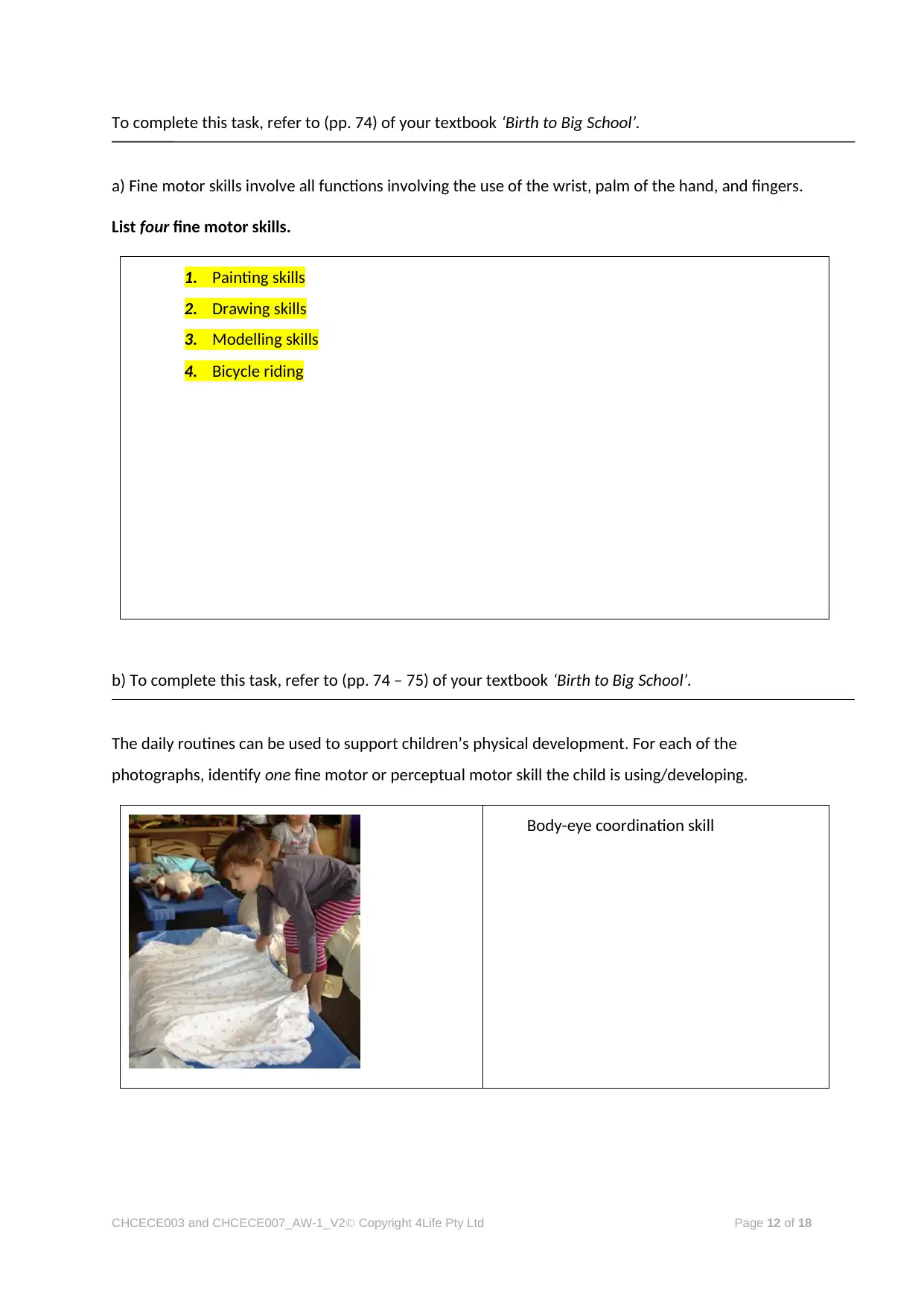
To complete this task, refer to (pp. 74) of your textbook ‘Birth to Big School’.
a) Fine motor skills involve all functions involving the use of the wrist, palm of the hand, and fingers.
List four fine motor skills.
1. Painting skills
2. Drawing skills
3. Modelling skills
4. Bicycle riding
b) To complete this task, refer to (pp. 74 – 75) of your textbook ‘Birth to Big School’.
The daily routines can be used to support children’s physical development. For each of the
photographs, identify one fine motor or perceptual motor skill the child is using/developing.
Body-eye coordination skill
CHCECE003 and CHCECE007_AW-1_V2 Copyright 4Life Pty Ltd Page 12 of 18
a) Fine motor skills involve all functions involving the use of the wrist, palm of the hand, and fingers.
List four fine motor skills.
1. Painting skills
2. Drawing skills
3. Modelling skills
4. Bicycle riding
b) To complete this task, refer to (pp. 74 – 75) of your textbook ‘Birth to Big School’.
The daily routines can be used to support children’s physical development. For each of the
photographs, identify one fine motor or perceptual motor skill the child is using/developing.
Body-eye coordination skill
CHCECE003 and CHCECE007_AW-1_V2 Copyright 4Life Pty Ltd Page 12 of 18
⊘ This is a preview!⊘
Do you want full access?
Subscribe today to unlock all pages.

Trusted by 1+ million students worldwide
1 out of 18
Related Documents
Your All-in-One AI-Powered Toolkit for Academic Success.
+13062052269
info@desklib.com
Available 24*7 on WhatsApp / Email
![[object Object]](/_next/static/media/star-bottom.7253800d.svg)
Unlock your academic potential
Copyright © 2020–2025 A2Z Services. All Rights Reserved. Developed and managed by ZUCOL.




